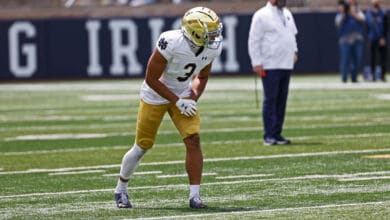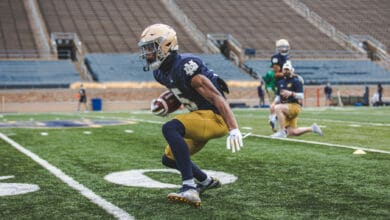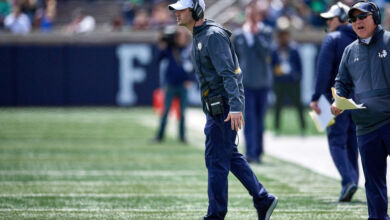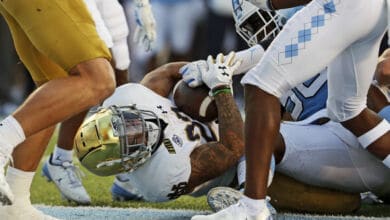
Let’s take a step back to figure out how we got here.
In the spring of 2018, Armstrong was set to play wide receiver for Notre Dame, as a redshirt freshman. He was recruited to play that position out of high school and shined on the scout team during his freshman season. However, with the word filtering through Notre Dame circles that Dexter Williams was going to be suspended for the first four games of the 2018 season, changes needed to be made. The only returning running back with any sort of experience was Tony Jones Jr., with Deon McIntosh and CJ Holmes both being dismissed from the team during winter workouts, putting the running back room in a bad spot.
Enter Armstrong, who showed impressive ability as a kick returner in high school, making the move from receiver to running back. He was impressive in the spring, and eventually beat out Jones Jr. for the starting position heading into Michigan week. He scored two touchdowns against the Wolverines and was proving to be a dual threat out of the backfield as a receiver. He scored five touchdowns in the first four games, before an infected knee and subsequent high ankle sprain derailed his season.
A similar story played out in 2019. Armstrong was set to be a major part of the Notre Dame offense when a abdominal injury during the first series of the season knocked him out for the better part of the first two months, and his season never got on track.
As the team heads into the spring of 2020, it’s fair to wonder where Armstrong would be best utilized with a luke warm running back performance in 2019. Should he stay at running back? Should he move to a receiver role? The offseason is for baseless speculation, so let’s speculate.
The Case For Running Back
The sample size is admittedly small, but when Armstrong has been healthy, he’s shown the ability to be a solid running back with adequate burst to fill the role. He’s also a heavy runner who is tougher load to bring down than you’d think from a converted receiver. Pre-injury in 2018, Armstrong carried the ball 47 times for 245 yards, which projected over a 13 game season is a 153 carry, 796 yard performance, just behind Tony Jones Jr‘s numbers in 2019. Obviously, that kind of production is certainly useful to the team, especially when you consider there is no one else on the roster who comes close to it.
That’s another factor here, which is pretty big. Behind Armstrong is 94 combined carries from the running back position. However we feel about Armstrong’s ability, some leadership is needed in the room and Armstrong can provide that. He’s entering his senior season at Notre Dame, he’s been in some big time games, and he’s got some nice production. Experience is not nothing.
Armstrong is also the most versatile of all the backs. He’s shown he can be an inside runner, can get to the perimeter, can block, and can catch. There isn’t another skill set like his.
(Whatever the case, I think Armstrong needs to drop weight. He was too heavy last season, and no matter what happens with his position, his workload won’t be such that he’s touching the ball 17-20 times a game. A loss of 10-15 pounds to 205-210 would do him some good.)
The Case For Wide Receiver
The best Armstrong has looked at running back for Notre Dame was the beginning of 2018. That was two seasons ago. It’s hard to judge him on last season because the injury really affected him and we never got to see where he was going as a runner, but what we ended up seeing wasn’t very inspiring. He finished the season with 46 carries for 122 yards (2.65 ypc) and one touchdown. He also had the unfortunate fumble against Virginia Tech that was returned for a touchdown which, aside from the fumble, wasn’t the best piece of goal line running we’ve ever seen.
This case will get a lot stronger if Notre Dame ends up with grad transfer Trevor Speights out of Stanford, who has a similar skill set to Armstrong, and is a running back all the way. There wouldn’t be an adjustment period for him and would also mitigate the need for Armstrong to stay simply to check off the versatility box. Speights would also give Notre Dame that veteran presence in the locker room.
We know Armstrong works as a receiver, he’s got 27 receptions for 256 yards the past two seasons, and his size would also present problems for the opposition down field from the slot, as we saw against Ball State and Navy in 2018.
This move would also eliminate a log jam at the position. Assuming Speights joins, that’d make seven scholarship running backs once Chris Tyree arrives in the fall, an untenable situation for that position. A move to Armstrong’s more natural position could make sense, numbers wise.
What’s Most Likely?
Coaches love versatility more than anything, so the most likely scenario is Armstrong is a true hybrid player, splitting time between both positions and giving Tommy Rees options with the offense. Armstrong gives them options with two back sets and the ability to create favorable matchups. Taking that away is not something Rees or Kelly is likely to do. Either way, as stated above, Armstrong needs to drop weight. He’s at his best when he’s elusive and nimble, something he was not last season, which is why I think we saw a drop in his production. 205 pound Jafar is the way to go, allowing him to effectively play either running back or slot and give Notre Dame the weapon they’ve always wanted in him.




Get the ball in his hands as often as possible
Let me ask and I am posing this as a question. When I see articles on what is wrong with ND running backs and then read another article on why cant NDs Oline run block better? Which is right and which is wrong? I didn’t see any holes for Jafar when he got these hand-offs, however I did see Tony run away from 4 foot holes. I don’t know, The offensive staff needs to circle the wagons and figure it out. I am no football guru, but watching highlights and games over and over. But if Jafar has some open lanes, I think he turns the corner. I look back to when Everett Golson went TO happy. I felt like he had no confidence in the defense that was decimated two years in a row and had no confidence in his Oline. I am nobody, I got it. Just food for thought. What do you think?
ND program has arrived such depth to where each position coach must develop then plug in that talent depending on the opponent each week and the play call situation each game.
If he reasserts that confidence in his abilities both he and his coaches had in him, then Jafar needs to play the position that maximizes his potential as each game’s circumstance presents itself.
As both BC and Greg point out, versatility in scheme is the best way to maximize the talent you have recruited and developed.
That’s why the position coaches get the big money or, in NDs case, should get the big money!
You hit the nail on the head at the end. His versatility is such that he should be included in two back sets. He could be a matchup nightmare by moving him around.
ND needs to be less predictable. More two back sets. More multiple TE sets. Etc
I saw a lot of split back plays in the “nobody bowl”. That tells me that Coach Rees probably will be more autonomous than some of our posters thought. I hope it stays that way, at least on routine downs.
BGC ’77 ’82